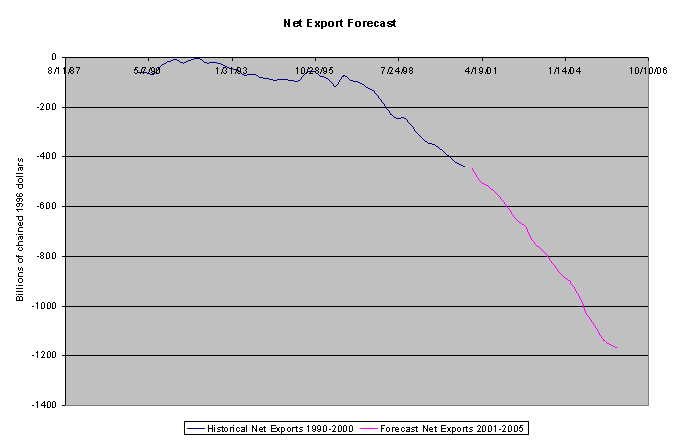U.S. Net Exports: A Five Year Forecast
From
a Keynesian Aggregate Expenditure Perspective
TAYLOR BRUMBELOE
College of Business
Western Carolina University
Abstract
U.S. net exports are forecast to decrease each
year from 2001 through 2005.The
forecast is based on a Keynesian aggregate expenditures model, which assumes
fixed interest rates, consumption spending, government spending and real
GDP.The explanatory variable used
is gross domestic product (GDP).This
variable is taken from the Federal Reserve Bank of St. Louis Federal Reserve
Economic Data (FRED).The variable
is observed quarterly.The sample
period for the data will be from the first quarter of 1990 to the fourth
quarter of 2000.From 1990.1 through
200.4 real gross domestic product has risen and real net exports have fallen
dramatically. (JEL: E12, H50)
Part 1. Introduction
This paper forecasts U.S. net exports (NX) for the
years 2001-2005.The explanatory
variable is Gross Domestic Product (GDP).The
approach is based on the Keynesian aggregate expenditure model using new
estimates of real GDP.The Keynesian
approach benefits from simplicity of implementation and makes known the
role of gross domestic product in driving aggregate economic activity.
The rest of this paper is organized as follows: part
2. presents the data used to forecast net exports; part 3. presents the
theoretical basis for the approach adopted in forecasting net exports;
part 4. presents forecasts of net exports for 2001-2005; part 5. evaluates
the importance of the forecast for the economy; and part 6. discusses conclusions
for economic policy.
Part 2. Data
All variables are taken from the Federal Reserve
Bank of St. Louis Federal Reserve Economic Data (FRED).The
measures of GDP and net exports are FRED variables GDPC96 and NETEXC96,
real GDP measure in chained 1996 dollars, seasonally adjusted annual rates
(SAAR).The primary source is the
U.S. Department of Commerce Bureau of Economic Analysis.These
are quarterly variables.The value
given for the first month of each quarter (January, April, July, and October)
was taken as the value for that quarter.The
sample period for the data is from the first quarter of 1990 to the fourth
quarter of 2000.The forecast horizon
is five years into the future.
Part 3. Forecasting with the Keynesian Aggregate Expenditures Model
This forecasting project assumes that gross domestic
product will rise over the next 20 quarters and will have a negativeeffect
on U.S. net exports.This is a
simple model and is very appropriate for forecasting short-term net exports.The
Keynesian net exports function can be written as:
NX=Y+C+I+G
Since real GDP equals real aggregate expenditures
(AE) in equilibrium, the AE function can be written as:
Y=AE=C+I+G+NX
The values for projected future net exports is expressed
in the following equation:
NX=b0+b1 (NXt-5)-b2 (GDPt-5)
1.
Part 4. U.S. Net Exports: A Short-Term Projection 2001-2005
Forecasting equation one was estimated by an ordinary
least square regression for the period 1990.1-200.4.The
R-squared of the estimate is 0.97222054.The
F-statistic for the joint null hypothesis of zero slopes is 367.4771.The
estimate of the equation is:
NX=2426.617+0.20932(NX-5)-0.37259(GDP-5)
The regression statistics were very good with R-squared
being very close to one.Using this
equation it was found that net exports are negatively effected by a rise
in U.S. GDP.Over the projected time
period, net exports will double but in the wrong direction.

Part 5. Cloudy Forecast for Net Exportís Future
This forecast for real net exports was very unfavorable.According
to the forecast, as gross domestic product rises, net exports will fall.This
most likely would be caused when the U.S. economyís prices go up and other
countries cannot afford to buy our products.
Part 6. Policy Conclusions
Real net exports are forecasted to decrease over
the next five years.If this forecast
turns out to be correct, many U.S. businesses will lose money when foreign
buyers cannot purchase U.S. products.If
the U.S. imports more than it exports, then the U.S. deficit will increase
sending taxes up again.Since, U.S.
businesses have no effect on the change in prices, they cannot do much
until the government regulates.It
would be the job of the U.S. government to regulate exporting prices and
get the export and import rates back at an equilibrium or at least have
more exports than imports.The
Fed would also have a part in regulating prices.They
would have to work with the U.S. government and figure out a way to regulate
market prices so that foreign buyers would be able to purchase more of
our products again.
Reference
Federal Reserve Bank of St. Louis, Federal Reserve
Economic Data (FRED) (12-31-98), http://www.stls.frb.org/index.html
(2-22-01)
